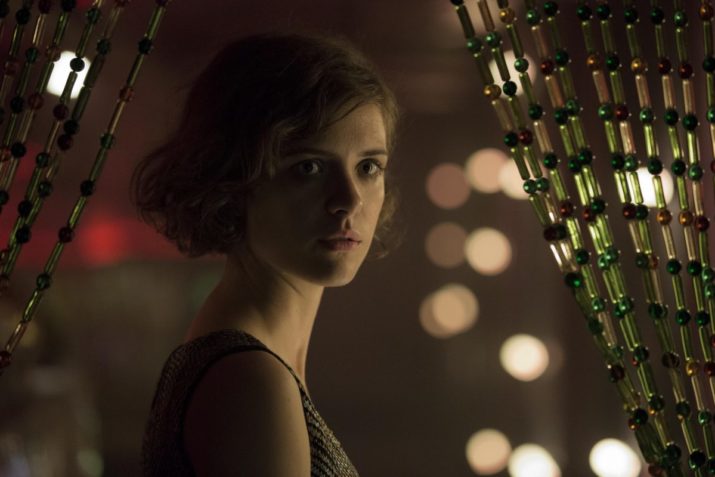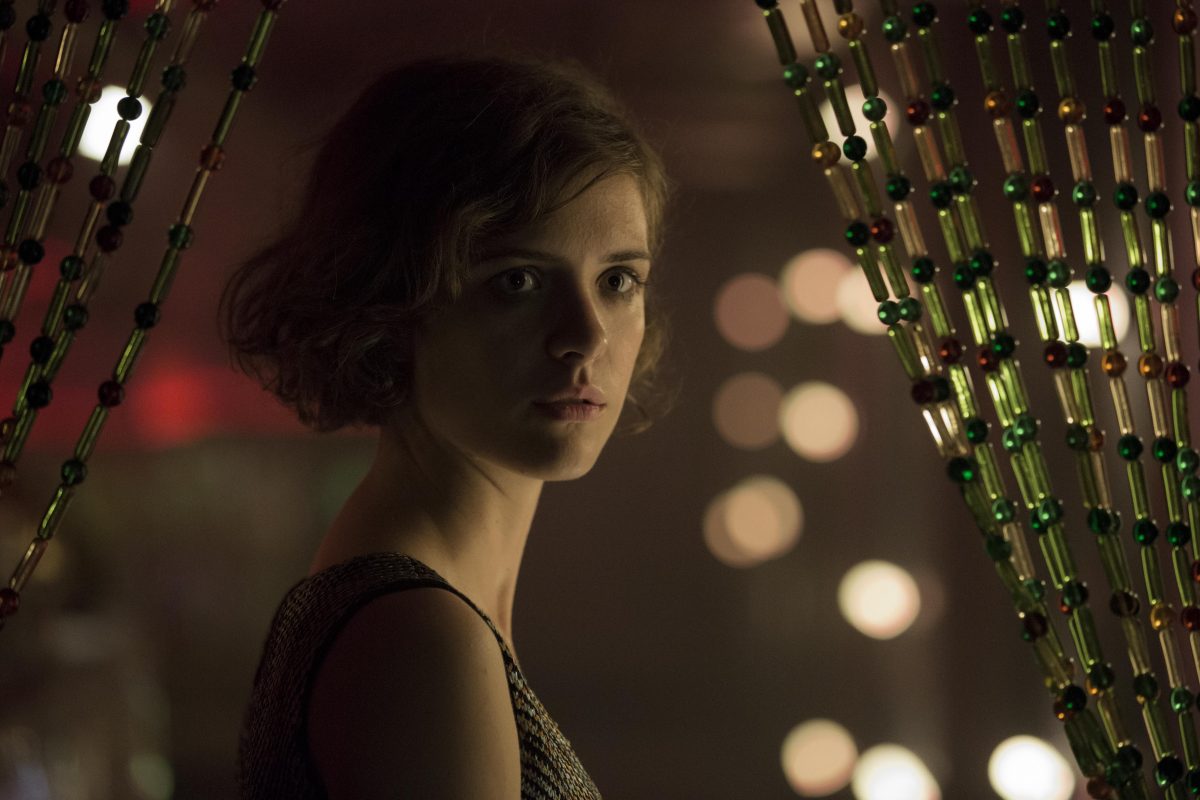

This is part of our special feature, European Culture and the Moving Image.
In the fall of 2019, the European Film Academy announced its creation of a new award category, one that would allow the EFA to “remain relevant” in the eyes of younger viewers and in light of clear changes in visual media creation and distribution. The new category rewards European Achievement in Fiction Series, and the inaugural award went to the German writer-directors Achim von Borries, Henk Handloegten, and Tom Tykwer for Babylon Berlin.[1] The popular and critically acclaimed television series Babylon Berlin (hereafter BB) first aired in Germany, Italy, and the UK in October 2017 on the cable channel and streaming service Sky. BB was quickly distributed across Europe due to deals brokered between Beta Film (one of BB’s co-producing partners) and cable conglomerates including HBO Europe, as well as national distributors in individual countries.[2] BB has been touted as the most expensive television series ever to be produced on the European continent, as well as the most expensive non-English language series of all time, due to its nearly 40-million-euro budget. The series has been praised in the press and awarded myriad prizes for its high production values, its lavish sets and costumes, and for the performances of its leading actors, Volker Bruch, who plays Gereon Rath, the haunted, morphine-addicted police detective recently transplanted from Cologne to Berlin, and Liv Lisa Fries, who plays the plucky Charlotte (Lotte) Ritter, the police stenotypist by day and night club dancer/sex worker by night who hopes to get out of her family’s cramped tenement housing and become the first woman to serve as a homicide detective on Berlin’s police force.
Lotte is described by the official website for BB as “determined and resourceful, poor but sexy.”[3] Those who are familiar with recent Berlin history will immediately recognize the latter half of this description as a popular slogan for the city, coined in 2003 by its social democratic and first openly gay mayor Klaus Wowereit. Lotte, a working-class, sexually promiscuous woman who frequents the many erotic entertainment venues of late 1920s Berlin, is marketed as the embodiment of Berlin itself, a gesture that in turn carries echoes of the early twentieth century, when the allegory of the Whore of Babylon was often used by both its detractors and admirers to signify the supposedly debauched German capital.[4] It comes as no surprise, therefore, that the creators of the series chose to call it Babylon Berlin, rather than give it the same name as the literary work that inspired it, the bestselling hard-boiled detective novel Der nasse Fisch (The Wet Fish, 2007) by Cologne-based author Volker Kutscher.[5] Babylon carries with it the biblical connotations of sin, excess, and imminent demise that still cling to stories about and histories of Weimar Germany, and Babylon’s revival in the title of the series refreshes the image of Berlin as the central European capital of hedonistic nightlife and club culture in the twenty-first century. This image of Berlin has certainly driven the immense popularity of BB across Europe and beyond, as has its long-arc storytelling, until recently still an unusual format for a non-English-language series. In the “making of” featurette that accompanied the release of BB on the German public television station ARD in the fall of 2018, one of the series’ producers and a co-founder of the production company X-Filme Creative Pool, Stefan Arndt, describes the impetus for both the company, which was established in 1994, and the hit series thus:
German content, akin to the creative power of Goethe and Schiller, yes, from Germany and presented to the world as German films. That was our idea right from the start, when we founded X-Filme, and therefore we decided to cast Berlin, our city that we really know, in the starring role, and broadcast it to the world by making a German series, and to do that in the German language (emphasis added).[6]
In this quote the idea of Germanness—a designator that seems to imply both authenticity and originality—appears as many times as there are lines: the makers of German content in the German language, made in Germany, also stake a claim to their national capital, Berlin.
Yet, even as the marketing of the series has played up its Germanness—building on X-Filme’s model of producing quality, auteur-driven films “that are both challenging and accessible for international audiences”[7]—in fact BB can be understood as an exemplary European audiovisual production, and one that represents a new stage of platform-driven image creation for global exhibition. At first glance, the series seems to defy certain paradigms that have defined the European moving image in the era of cinema: its budget relies chiefly on German funding sources; it is a largely monolingual production; it was shot entirely on location in Berlin and at the nearby Babelsberg Studios; and most of its recognizable star actors are German-born. In terms of financing, language, shooting locations, and casting choices, then, the series indeed appears to reflect the Germanness extolled by Arndt. However, a closer look at BB reveals the complex inflection of localization, Europeanization, and globalization that drive its production context, formal-aesthetic choices, and narrative developments, including its representation of Weimar Berlin.[8]
There can be little doubt that BB marked a new phase in visual media production for Germany, a country that had, until 2017, lagged behind other European nations in the creation of “prestige television” deemed marketable outside its borders. 2017 saw the release of Dark and 4Blocks, German-language series made with global audiences in mind that were developed and funded by private media companies—Dark by Netflix and 4Blocks by TNT. The producers of BB, in contrast, sought and secured a hybrid funding structure more akin to the British model, where the national public broadcaster (BBC) teams up with pay TV and streaming services to make, market, and distribute lavish historical productions such as Downton Abbey. Indeed BB breaks the mold in several ways. It marks the first partnership between a public broadcast network (ARD/Das Erste) and a private channel (Sky), supported by funds from regional (Film- und Medienstiftung NRW; Medienboard Berlin-Brandenburg), federal (the brand-new German Motion Picture Fund, a subvention program created specifically for BB), and transnational organizations including the European Union and Creative Europe.[9] This partnership meant that BB aired first on Sky, where it was available only to pay subscribers of the cable channel or its streaming service in Germany and other European markets, an unusual arrangement for a publicly financed show. Even so, the partnership has helped to re-energize the public network by drawing a younger, mass viewership, many of whom watched BB for free on ARD’s website after its public release in the fall of 2018; it also guaranteed a high-quality production that looks and feels more like a long-format film than a television show. In the words of Nico Hoffmann, the head of Germany’s storied film-production company UFA (Universal Film Aktiengesellschaft), itself a product of Weimar-era Berlin, the collaboration between media platforms that made BBpossible was nothing short of “a paradigm shift” within German visual media culture.[10]
In fact, the funding model of BB more closely resembles the complex assemblage of production and distribution partners commonly required to finance a feature film in Germany than the model that has predominated in television, where single broadcasters have typically commissioned shows.[11] BB differs from conventional television in terms of its writing, development, and shooting structure as well: it melds the practices of auteur-driven European art cinema, where showrunners Tykwer, Handloegten, and Borries got their start, with procedures familiar from transnational television production, including strategies that Tykwer adapted from his work with the American filmmakers Lana and Lily Wachowski.[12] Underwritten by its large budget and especially the initial investment from Beta Film with an eye to foreign sales, the show was incubated over an uncommonly long three-year period, during which the showrunners developed a writing process that facilitated BB’s complex mode of storytelling. As media studies scholar Florian Krauß shows in his examination of BB as a ground-breaking work of quality TV, the showrunners’ creative process benefited from an atmosphere of collaboration reminiscent of a writers’ room, but quite unlike the writers’ rooms that predominate in US television. While US writers’ rooms operate hierarchically, with the showrunner as creative boss over a staff of writers, the three writer-directors of BB were entirely responsible for the content of the series’ first three seasons, enjoying an unparalleled degree of creative autonomy. Their novel approach to filming BB was modeled on a method that Tykwer learned from the Wachowskis: the series was shot in three parallel units, each overseen by one of the showrunners, with three separate cinematographers, on a location-by-location basis, with all scenes taking place in a given location (e.g the Moka Efti night club) shot at once. The full series came together only at the end of the entire shoot in three separate editing rooms. This cost-effective way of proceeding made it possible for the show to use iconic shooting locations such as Berlin’s Alexanderplatz (which was shut down entirely for 24 hours for BB’s shoot, a rarity), but it also meant that the actors seldom had a sense of the show’s broader narrative arc or their own character arcs, which fostered an immersion in each moment and perhaps helped to convey the sense of uncertainty that pervades the show.
The production context of BB—including its unparalleled budget, unique development process, multiple shooting locations, and emphasis on editing—underpins the series’ dynamic approach to narrative complexity and visual spectacle. BB exemplifies the shift to “engagement” rather than “appointment” viewing, which media scholar Henry Jenkins has described as a modality that is both enabled and demanded by the “new economic imperative” of media conglomeration.[13] Like the transmedia productions Jenkins examines (epitomized by the Wachowskis’ Matrix franchise)—productions whose complexity cannot be contained by one platform—BB is marked by the blurring of lines between historical reality and fiction; the promotion of a cult status that relies on quotes, archetypes, and references; the placement of clues, Easter eggs, and allusions that require collective intelligence to decipher (driving the proliferation of blogs, Wikis, and subreddits devoted to the show); and a constant deferral of narrative enigmas. The series’ concomitant emphasis on worldmaking is visible in its attention to art direction, costuming, and mise-en-scene, and in its notable use of digital aesthetics.
Even as Jenkins concedes that the power and agency to participate is unevenly distributed across populations, groups, and individuals, he famously argues that transmedia storytelling promotes a participatory mode of viewing that contrasts with older models of passive media consumption. Certainly, BB promotes the “cosmopolitanization of television audiences, styles, and viewing habits” that Ramon Lobato identifies as a potential advantage of transnational broadcasting in the digital age.[14] With its deep dive into political and cultural events in Berlin during the globally significant year of 1929—including the murder of communist protestors by the SPD-controlled police force, the activities of SA brownshirts modelled on the Nazi martyr Horst Wessel, the “Threepenny Fever” that gripped the capital after the premiere of Bertolt Brecht and Kurt Weill’s musical, and Marlene Dietrich’s screen tests heralding the arrival of sound film—BB offers German heritage for transnational consumption. But, in keeping with the show’s promotion of participatory viewing, this is a thoroughly hybridized, pop version of German heritage well calibrated to reach audiences beyond Germany with its pastiche of pan-European elements and transhistorical styles.[15] Drawing on remediations of Weimar culture over the course of time, the BB universe, as historian Julia Sneeringer shows, includes traces of post-punk culture in its musical choices, evident for instance in its inclusion of 1980s-era songs and a cameo appearance by British singer Bryan Ferry. The show’s trademark mashup aesthetic also extends to its costumes by the French designer Pierre-Yves Gayrand, whose imaginative approach draws as much on the style of Rainer Werner Fassbinder’s miniseries Berlin Alexanderplatz (1981) as on the film costumes of the 1920s to encourage what Germanist Mila Ganeva terms “sartorial fetishism,” a mode also on view in period dramas like The Crown.[16] BB’s attention to Weimar culture as one of Germany’s and Europe’s key historical imaginaries is amplified through these aesthetic choices.[17]
Yet even as BB aims to promote and disseminate German culture and European values to a cosmopolitan viewing audience, transnational distribution retains a mixed promise in the neoliberal age, when market considerations trump cultural imperatives. Varied business models and priorities, content licensing issues, and forms of censorship (among others) complicate the global operations of Sky and Netflix. The politics of these platforms are thus significant not only for expanding the distribution and exhibition of quality TV made in Germany, but also for the way they drive the representational choices of series like BB in tandem with global imperatives.
The question of LGBTQ visibility is a case in point. While known for its “narrowcasting” (developing shows for specialized audiences) and recognized as a leader in LGBTQ representation, Netflix has also considered censorship abroad to be one of its main financial risks, especially since the company’s global expansion in 2017, when it commenced operation in 190 countries worldwide. As historian Javier Samper Vendrell demonstrates, the global distribution deals that enabled BB’s high production values certainly played a role in its choices regarding queer content.[18] BB’s showrunners walk a fine line between celebrating and condemning non-normative gender expression and sexuality. While the series allows its lead characters to frequent queer clubs and even to experience playful moments of queer desire, more often than not it channels sexual desire back into the heterosexual romance and enacts violence on its most gender-bending characters. And yet, the heterosexual relationship is also embattled, dissatisfying, and filled with grief and shame. Ultimately, BB’s depiction of the instability of gender and sexual norms and its deferral of heterosexual closure offer what Samper Vendrell identifies as moments of queer possibility, even as the series succumbs to common pitfalls of LGBTQ representation on television.
Playing as cleverly—and often painfully!—as it does with viewers’ hopes and expectations, and eschewing neat plot resolutions, BB enacts the tensions between progress and backlash, innovation and tradition that were so central to the period it depicts and that seem so prescient in the second decade of our own uncertain century. Weimar Berlin’s allure, after all, was that of the hub of European erotic entertainment culture, of avant-garde experimentation in the visual, performing, and literary arts, of technological and scientific advances. Weimar’s political stability and its hope as a democracy were also heavily dependent upon Germany’s relationship with the rest of Europe, particularly with its former arch-enemy, France. In re-imagining European community through the lens of Weimar history at a moment once again characterized by the resurgence of right populism, BB reveals how important this relationship between Germany and France was for the survival of Weimar democracy by weaving the historical figures of Gustav Stresemann and Aristide Briand, whose diplomatic collaboration won them the Nobel Peace Prize in 1926, into the plot and by staking nothing less than the future of the Republic on their survival. Weimar was plagued, especially in its final years, by political extremism, and while the series does depict communists as critics of the Republic, it takes great pains to focus on the threat from the right, revealing Nazis to be an emerging power aided and instrumentalized by nationalist military and industrial elites. Weimar democracy was new, and it was fragile, like so many of the new democracies that struggled to survive across Europe during the interwar period, and while most of these European democracies also failed, none did so in such a catastrophic way as Weimar. And yet, BB is more than a crime story, more than political intrigue, more than a warning against right-wing populism. In scenes and sequences that might seem like filler or comic relief to more casual viewers, BB contemplates the growing pains, the uncertainty of modernity: when investigative journalists lament the visual turn from print newspapers to illustrated tabloids, when the shift from silent to sound film seems like a deadly enterprise, when surveillance equipment is tested in police vans and offices, when the protagonist takes his first flight and can hold down neither his lunch nor his sense of wonder. In its contemplation of visual and sound technologies, BB pays homage to one of the most important sites of modern film and television production in Europe: Berlin. At the same time, it demonstrates through its own audiovisual artistry the transformative power of new media today.
In announcing BB as the recipient of the inaugural Award for Achievement in Fiction Series, the EFA proclaimed, “With this award, the European Film Academy wishes to pay tribute to a ground-breaking series, at the same time a passionate cinematic spectacle and a precise depiction of the political and social realities in 1920s Berlin. Through the eyes of a visiting police detective, BABYLON BERLIN allows the audience in and outside of Germany to witness the crucial political and social developments on different social levels of the Weimar Republic.”[19] The EFA’s tribute concisely names the qualities that contribute to BB’s sui generis status as a distinguished European audiovisual production: it breaks new ground through the establishment of an innovative public-private funding structure enabling its blockbuster format (with 157 characters, 300 shooting locations, and 5000 extras); its spectacular, kaleidoscopic style develops a citational aesthetic rife with intermedial references to technologies of information and entertainment as well as to resonant films, music, literary, and journalistic texts; and its remediation of Weimar Berlin offers a panoramic view of politics, crime, culture, gender, and sexual relations in the German capital with transhistorical echoes in the uncertain times of the 21st-century present.
Hester Baer
Jill Suzanne Smith
[1] The EFA announced the award winners in September 2019 and honored its recipients in December of that year. Seehttps://www.europeanfilmacademy.org/Press-Releases-detail.12.0.html?&no_cache=1&tx_ttnews%5Btt_news%5D=708&cHash=863c00da2b5ac0810f23fc4ffe4c38d0. Last accessed July 2, 2021.
[2] For a more comprehensive list of the various national broadcasting organizations that made deals with Beta Film to show the series in their respective countries, see Stewart Clarke, “HBO Europe Picks up German Drama ‘Babylon Berlin,’” Variety, https://variety.com/2017/tv/news/hbo-europe-buys-babylon-berlin-1202588085/. Last accessed July 2, 2021. Netflix picked up the series and broadcast it to viewers in Australia, New Zealand, and the United States in January 2018. By the time of its release in Germany, Beta had sold viewing rights to 60 countries worldwide. See “Zuschauerrekord,” Frankfurter Allgemeine Zeitung, October 17, 2017.
[3] See the description of Lotte on https://babylon-berlin.com/en/cast/liv-lisa-fries-charlotte-ritter/. Last accessed July 6, 2021.
[4] For a more extended analysis of the Whore of Babylon as allegory for Berlin, see Jill Suzanne Smith, Berlin Coquette: Prostitution and the New German Woman, 1890-1933 (Cornell UP, 2013). The Whore of Babylon is a key apocalyptic trope in Alfred Döblin’s modernist novel Berlin Alexanderplatz: Die Geschichte von Franz Biberkopf (Berlin Alexanderplatz: The Story of Franz Biberkopf) which was recently adapted to the cinema for the third time by Burhan Qurbani (Berlin Alexanderplatz, 2020).
[5] Volker Kutscher, Der nasse Fisch: Gereon Raths erster Fall (Cologne: Kiepenheuer & Witsch, 2007). Kutscher’s series, which now encompasses nine volumes and counting, has been translated into English, Czech, Dutch, French, Italian, Spanish, and Swedish, and translations into other European languages are ongoing/forthcoming. Der nasse Fisch, on which the first two seasons of BB are based, appeared in English as Babylon Berlin (New York: Picador, 2018). Season 3 is based on Kutscher’s Der stumme Tod (Cologne: Kiepenheuer & Witsch, 2009), available in English as The Silent Death (New York: Picador, 2018).
[6] The featurette is included in the special features of the DVD release of Seasons 1 and 2 of BB (Universum Film, 2018). All translations from the German are our own unless otherwise noted.
[7] See the X-Filme Creative Pool Profile page: http://www.x-filme.de/en/profile. Last accessed July 7, 2021.
[8] We approach our analysis as two scholars who are currently in the process of assembling the first volume of essays on the series, one that views BB through multiple lenses: fashion and set design, film and media studies, art history, the history of journalism, psychoanalysis, gender and sexuality, and music. We have participated in conference panels and academic forums, led on-line webinars, and taught the series to our students. We are also—albeit not uncritical—fans who binged on Season 3 during the Covid-19 lockdown. Our discussion of BB here is, therefore, informed by our own work on various digital and analog platforms, and by the emerging research on the series that we have the privilege to collectively read and review on the way to publication. See Hester Baer, “Watch-Klatsch: Babylon Berlin,” Webinar Series, Goethe-Institut, Washington, D.C. (Summer 2020), available on YouTube, https://www.youtube.com/watch?v=Ff8tHkq3G7s; and Jill Suzanne Smith’s contributions to the forum “Babylon Berlin: Media, Spectacle, and History,” edited by Veronika Fuechtner and Paul Lerner, Central European History 53 (2020): 835-854.
[9] On BB’s funding structure, see Lisa Goldman, “Die Superserie: ‘Babylon Berlin’ ist die teuerste deutsche Fernsehproduktion aller Zeiten. Was haben die Zuschauer davon?” Die Zeit, October 19, 2017 (43), 33. See also Florian Krauß’s contribution to our volume, which focuses on BB as an example of quality TV. On BB’s prestige status on the current European media landscape, see Gilles Fontaine and Marta Jiménez Pumares’s report on European High-End Fiction Series: State of Play and Trends (European Audiovisual Observatory, 2020), 62.
[10] See Michael Hanfeld’s interview with Hofmann, “Jeder braucht heute Bilder, die bewegen,” Frankfurter Allgemeine Zeitung, June 21, 2018, n.p.
[11] On the changing funding structures for film productions in Germany and Europe, as well as the relationship between film production and television programming, see Randall Halle, German Film after Germany: Toward a Transnational Aesthetic (Urbana: University of Illinois Press, 2008); see especially pages 3, 102-103, 169-170.
[12] All three directors began their careers as auteur writer-directors of feature films in Germany. The debut features of both Handloegten (Liegen lernen / Learning to Lie, 2003) and von Borries (Was nützt die Liebe in Gedanken / Love in Thoughts, 2004) were both produced by X-Filme Creative Pool, the company that Tykwer co-founded with Arndt and filmmakers Wolfgang Becker and Dani Levy in 1994, and which came to prominence with Tykwer’s breakthrough film Lola Rennt (Run Lola Run, 1998). Tykwer later went on to an international career, including collaborations with the Wachowski siblings on the feature film Cloud Atlas (2012) and the Netflix series Sense8 (2015-18).
[13] Henry Jenkins, Convergence Culture: Where Old and New Media Collide (New York: NYU Press, 2006), 98.
[14] Ramon Lobato, Netflix Nations: The Geography of Digital Distribution (New York: NYU Press, 2019), http://opensquare.nyupress.org/books/9781479882281/read/.
[15] On the show’s use of pastiche, see Sara Hall, “Babylon Berlin: Pastiching Weimar Cinema,” Communications 44.3(2019): 304-322.
[16] See Sneeringer’s and Ganeva’s contributions to our volume.
[17] See Thomas Elsaesser, Weimar Cinema and After: Germany’s Historical Imaginary (New York: Routledge, 2000).
[18] See Semper Vendrell’s contribution to our volume.




